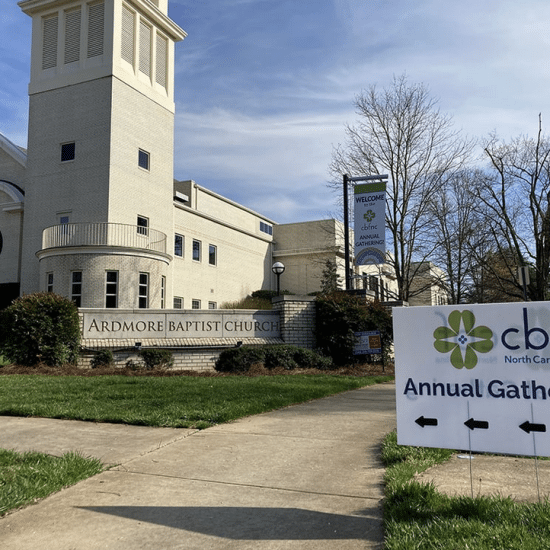
Growing up in a small town in the Midwest, I saw a lot of silos. They were hard to miss towering over the flat farmlands. And as a child of the Cold War, I often wondered what secrets they might hide like the missiles or underground fallout bunkers that children murmur about to each other on the playground. One place I never saw one, though, was at a church; and yet, our churches are known for being places of multiple ministry silos. The unfortunate consequence of this separation of ministries by age and stage of life is that we miss out on one of our biggest monopolies in the world today: being a place of true intergenerational community.

Sarah Blackwell
It is not hard to get sucked into lamenting of state of the church in America as we see declining numbers and increasing polarization. Rather than assessing all the problems, I think we could spend a bit more time leaning into our monopolies. What does the church have a monopoly on? Well, first and foremost, we have the message of hope of the restoration provided by Jesus. We need to never lose sight of this fact. However, we also have an earthly monopoly that sometimes we fail to remember: a monopoly on building intergenerational relationships from birth through our most senior members.
Most of our world is spent siloed off into age group-specific activities that keep us in echo chambers of uniform perspectives. Our social media is divided by generation. Neighborhoods often attract people of similar ages based on the amenities such as senior living communities or new condo complexes near mass transit teaming with young professionals. With more remote work and less time in the office, even that time of cross-generational connection falls flat. One gift we as the church have to offer the world is the opportunity to form cross-generational relationships.
This is not just a nice thing to do; it has been shown to be a primary way to encourage lasting faith formation for all ages. In the book InterGenerate, Joseph P. Conway notes that the National Study of Youth and Religion shows that “separating kids into generational silos and focusing on short-term outcomes of attendance and safe adolescent behavior somehow minimized the depth and sacrificial aspects of the historic faith.” He also cites a study from Baylor in 2007 that found “the highest faith retention rate to be among teens participating in ongoing community service and reflection alongside adults.” A generation of youth ministry siloed off into cool spaces without intergenerational connection left young adults feeling like an appendage to the church community and not a vital part. If you felt like you were a vital part of something, would you be inclined to leave it behind?
We know that connectedness is a major indicator of well-being and that these types of relationships benefit both the older and younger generations; however, it is not easy to move our churches from the long-held models of “age and stage” programming. Since the adults are generally the ones planning the work of the church, some accommodation must take place. We must give up some of the ways we like things to be done to engage other generations that wield less power in our congregations. As Gareth Crispin explains in InterGenerate, “a theology of accommodation can provide theological reasoning and motivation for Christians with relatively more knowledge to set aside their own tastes and desires and seek ways to develop church structures and practices that aid those with less knowledge to participate within the community of faith.” We are going to have to give a bit on some of those ways “we have always done things” if we are going to be an integrative place for all generations.
We have no reason to believe that the early church was anything but intergenerational. We know parents brought their children to hear Jesus teach and preach. A young boy offered up his lunch to help feed the crowd of people gathered to hear Jesus. In Acts, we learn about entire households hosting gatherings. Imagine the beauty of all the people of God huddled together in a courtyard of a house hearing the teachings of Jesus: fathers with children in their laps, mothers with babies in their arms, elders in chairs around the sides, and young teens laughing with their friends. Together they modeled a way of life for each other in their communal meal and singing of hymns.

DroneImagineNation / Pixabay
The current research shows that children and young people that are encouraged to practice the liturgy of the church are more likely to remain engaged with church communities over their lifetime. The book Growing Young introduced the idea of “key chain leadership” where we give young people very real responsibility in the life of the church. Unfortunately, as megachurches siphon off members from smaller congregations around them, one of the things that is lost is the participation of all ages of members in worship. Gone are the renditions of “Amazing Grace” on the piano by an eight-year-old or the youth singing a solo or the testimony from the senior adult who tutors children each week or the baby dedication or the high school baccalaureate services in the name of slick “professional” productions. What is lost is irreplaceable.
What are ways then that your community can capitalize on our intergenerational monopoly?
• Include retreats or time away that are for a wider variety of members than just youth or children. I recently led a retreat for women from 24 to over 80. The beauty of seeing women of different generations share their life stories is powerful. Each generation has its own insights and gifts they bring to the table.
• Give different groups the opportunity to pray for each other. This year as we entered our Ash Wednesday service, we had everyone write their name on a sheet of paper. As people left, they took a name out of the basket to pray for during the season of Lent. My teen and tween had the opportunity to pray for a senior adult and an empty nester. These folks would not normally have been on their radar to be thinking about and praying for. Some people met each other for the first time during this time as they drew names of people who were “new-to-them.”
• Involve people of all ages in every worship service. It is not enough to invite the youth to lead one Sunday and the children another. We must find meaningful ways to invite the participation of all ages. We are teaching them liturgical practices. I know my own church growing up had junior deacons that helped to serve communion each Sunday. Participating in the act of handing out the elements deepened my own attachment to communion and made it more meaningful. This is not a way to just show some “cute kids” during worship, but true spiritual formation through participation in the rituals of the church. Recently our church has been including reflections on a question of the week from three different ages to amplify the theological voices of many stages in the worship service.
• Develop an intergenerational faith formation class. “Age and stage” faith formation has its own place and serves many helpful purposes. Some people, however, really flourish in a class that involves a multitude of age groups.
• Offer a chance to mix and mingle in an organized way. Last summer, we offered an event that resembled “speed dating” where younger and older members moved from table-to-table over dessert to simply get to know each other better. We also did an Advent installation for our entry area where we crafted around tables and discussed a variety of holiday-themed questions.
• Serve together in multi-age groups. In Passing on the Faith, Merton Strommen and Richard Handel site the best predictor of faith maturity to be participating in service projects. Real-life skills can be taught by mentors. Pulling together toward a common goal creates lasting ties and a formational experience.
• Read a book together as a church like Growing Young. While some might think this is just a book about getting more youth, it really is about integrating all members of a faith community into the life and worship of the church. We each can play a role in raising the next generation.
• If your church has a preschool or childcare center, investigate the possibility of having an adult day center for senior adults where the two groups can interact with each other.
We may be comfortable in our own silos with people that are the most like us; however, we miss a real opportunity to form beautiful cross-generational relationships. This is one area that faith communities have a real monopoly that we are not emphasizing enough. A few weeks ago, I followed one of our younger members through the line to greet new members that had just joined the church. She walked right up to the new members (a young adult couple) stuck out her hand to shake, introduced herself, and told them that she had been at the church for ten years and that they were going to love it here. They smiled and thanked the precocious tween who gave her a frank assessment of the situation. I thought to myself — how do I follow that welcome?
Here was a young woman who is confident in her belonging to a place and a community. She had learned hospitality and welcome from those that had done the same for her all her young life. She is a child of a new generation who sees fewer silos and more networks — where connectivity is the key. Remember when Isaiah points to the coming of the kingdom of God, it is a child that shall lead them. Let us follow her lead.
Sarah Blackwell is a contributing writer at Word & Way and a 2020 graduate of the Gardner-Webb School of Divinity. She is an adjunct instructor in the Religion and Philosophy Department at Wingate University in Wingate, NC and a D.Min. student at McAfee School of Theology. She enjoys working with youth and young adults at Providence Baptist Church-Charlotte. Her intergenerational faith formation book, God is Here is available through Amazon and other online book retailers. Follow her writings at www.proximitytolove.org.






